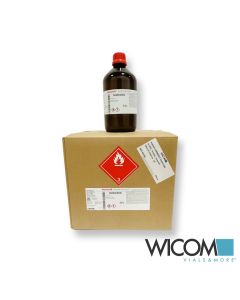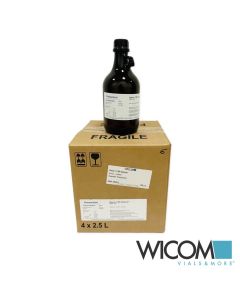Running medium chromatography
-
 Acetonitrile, CHROMASOLV, LC-MS Ultra Box with 6 bottels of 1l manufacturer: Hon...
WIC 60170Special Price $1,084.08 Regular Price $1,482.41 Bulk price $977.52Excl. VAT, excl. Shipping
Acetonitrile, CHROMASOLV, LC-MS Ultra Box with 6 bottels of 1l manufacturer: Hon...
WIC 60170Special Price $1,084.08 Regular Price $1,482.41 Bulk price $977.52Excl. VAT, excl. Shipping -
 Wasser, LC-MS Optigrade 4x2,5 L / Case manufacturer: Promochem
WIC 60201Special Price $150.99 Regular Price $195.53 Bulk price $108.52Excl. VAT, excl. Shipping
Wasser, LC-MS Optigrade 4x2,5 L / Case manufacturer: Promochem
WIC 60201Special Price $150.99 Regular Price $195.53 Bulk price $108.52Excl. VAT, excl. Shipping -
 Acetonitril, CHROMASOLV, LC-MS Ultra, 1l
WIC 60171Special Price $225.40 Regular Price $243.75 Bulk price $175.97Excl. VAT, excl. Shipping
Acetonitril, CHROMASOLV, LC-MS Ultra, 1l
WIC 60171Special Price $225.40 Regular Price $243.75 Bulk price $175.97Excl. VAT, excl. Shipping -
 Methanol, Chromasolv Hypergrade manufacturer: Honeywell Box with 4 bottels á 2,5...
WIC 60302Special Price $106.34 Regular Price $129.26 Bulk price $56.49Excl. VAT, excl. Shipping
Methanol, Chromasolv Hypergrade manufacturer: Honeywell Box with 4 bottels á 2,5...
WIC 60302Special Price $106.34 Regular Price $129.26 Bulk price $56.49Excl. VAT, excl. Shipping -
 Acetonitrilee isocratic grade for liquid chromatography LiChrosolv (Merck) Box w...
WIC 60181Special Price $271.45 Regular Price $378.02 Bulk price $248.82Excl. VAT, excl. Shipping
Acetonitrilee isocratic grade for liquid chromatography LiChrosolv (Merck) Box w...
WIC 60181Special Price $271.45 Regular Price $378.02 Bulk price $248.82Excl. VAT, excl. Shipping -
 n-Hexan 95% HPLC z.A. manufacturer: JT Baker Box with 4 bottels á 2,5l
WIC 60505Special Price $324.79 Regular Price $539.87 Bulk price $270.48Excl. VAT, excl. Shipping
n-Hexan 95% HPLC z.A. manufacturer: JT Baker Box with 4 bottels á 2,5l
WIC 60505Special Price $324.79 Regular Price $539.87 Bulk price $270.48Excl. VAT, excl. Shipping -
 Acetonitrile, GCRS Super Box with 4 bottels à 2,5l manufacturer: Honeywell
WIC 60105Special Price $263.72 Regular Price $382.39 Bulk price $205.95Excl. VAT, excl. Shipping
Acetonitrile, GCRS Super Box with 4 bottels à 2,5l manufacturer: Honeywell
WIC 60105Special Price $263.72 Regular Price $382.39 Bulk price $205.95Excl. VAT, excl. Shipping -
 n-Hexan f.d. Flüssigkeitschromatographie Lichrosolv manufacturer: Merck Box with...
WIC 60510Special Price $508.37 Regular Price $630.03 Bulk price $413.32Excl. VAT, excl. Shipping
n-Hexan f.d. Flüssigkeitschromatographie Lichrosolv manufacturer: Merck Box with...
WIC 60510Special Price $508.37 Regular Price $630.03 Bulk price $413.32Excl. VAT, excl. Shipping -
 Methanol for HPLC Gradient Grade / manufacturer Merck Box with 4 bottels á 2,5l...
WIC 60380Special Price $137.48 Regular Price $307.63 Bulk price $115.69Excl. VAT, excl. Shipping
Methanol for HPLC Gradient Grade / manufacturer Merck Box with 4 bottels á 2,5l...
WIC 60380Special Price $137.48 Regular Price $307.63 Bulk price $115.69Excl. VAT, excl. Shipping -
 Methanol, Chromasolv LCMS Ultra Flasche a 1L manufacturer: Honeywell
WIC 60370Special Price $75.93 Regular Price $97.65 Bulk price $65.07Excl. VAT, excl. Shipping
Methanol, Chromasolv LCMS Ultra Flasche a 1L manufacturer: Honeywell
WIC 60370Special Price $75.93 Regular Price $97.65 Bulk price $65.07Excl. VAT, excl. Shipping -
 Methanol, LCMS-Grade manufacturer: JT Baker Box with 4 bottels á 2,5l
WIC 60350Special Price $295.03 Regular Price $404.09 Bulk price $262.76Excl. VAT, excl. Shipping
Methanol, LCMS-Grade manufacturer: JT Baker Box with 4 bottels á 2,5l
WIC 60350Special Price $295.03 Regular Price $404.09 Bulk price $262.76Excl. VAT, excl. Shipping -
 Wasser, Chromasolv LC-MS Ultra (Flasche 1 Liter) manufacturer: Honeywell
WIC 60270Special Price $75.28 Regular Price $86.79 Bulk price $69.41Excl. VAT, excl. Shipping
Wasser, Chromasolv LC-MS Ultra (Flasche 1 Liter) manufacturer: Honeywell
WIC 60270Special Price $75.28 Regular Price $86.79 Bulk price $69.41Excl. VAT, excl. Shipping -
 Wasser LiChrosolv for die Chromatographie, for die LC-MS Box with 6 bottels á 1 ...
WIC 60225Special Price $155.23 Regular Price $172.50 Bulk price $124.48Excl. VAT, excl. Shipping
Wasser LiChrosolv for die Chromatographie, for die LC-MS Box with 6 bottels á 1 ...
WIC 60225Special Price $155.23 Regular Price $172.50 Bulk price $124.48Excl. VAT, excl. Shipping -
 Acetonitrile,for HPLC Gradient Grade / manufacturer Merck Box with 4 bottels of ...
WIC 60180Special Price $236.80 Regular Price $310.78 Bulk price $205.08Excl. VAT, excl. Shipping
Acetonitrile,for HPLC Gradient Grade / manufacturer Merck Box with 4 bottels of ...
WIC 60180Special Price $236.80 Regular Price $310.78 Bulk price $205.08Excl. VAT, excl. Shipping -
 Acetonitrile, CHROMASOLV, Gradient Grade for HPLC. manufacturer: Honeywell Box w...
WIC 60100Special Price $189.22 Regular Price $509.45 Bulk price $143.28Excl. VAT, excl. Shipping
Acetonitrile, CHROMASOLV, Gradient Grade for HPLC. manufacturer: Honeywell Box w...
WIC 60100Special Price $189.22 Regular Price $509.45 Bulk price $143.28Excl. VAT, excl. Shipping -
 Ethylacetat, manufacturer: JT Baker Ultra Resi-Anal. Box with 4 bottels á 2,5 Li...
WIC 65010Special Price $363.68 Regular Price $379.10 Bulk price $280.25Excl. VAT, excl. Shipping
Ethylacetat, manufacturer: JT Baker Ultra Resi-Anal. Box with 4 bottels á 2,5 Li...
WIC 65010Special Price $363.68 Regular Price $379.10 Bulk price $280.25Excl. VAT, excl. Shipping -
 Aceton puriss p.a. manufacturer: Honeywell Box with 4 bottels a 2,5l
WIC 63000Special Price $167.50 Regular Price $215.08 Bulk price $118.84Excl. VAT, excl. Shipping
Aceton puriss p.a. manufacturer: Honeywell Box with 4 bottels a 2,5l
WIC 63000Special Price $167.50 Regular Price $215.08 Bulk price $118.84Excl. VAT, excl. Shipping -
 Ethanol, absolut f. Analyse >99,8 (GC) reag. ISO, reag. Ph. Eur. Box with 4 bott...
WIC 60901Special Price $418.61 Regular Price $891.81 Bulk price $325.44Excl. VAT, excl. Shipping
Ethanol, absolut f. Analyse >99,8 (GC) reag. ISO, reag. Ph. Eur. Box with 4 bott...
WIC 60901Special Price $418.61 Regular Price $891.81 Bulk price $325.44Excl. VAT, excl. Shipping -
 Petrolether, 40-60°C for Rückstandsanalyse, manufacturer: Honeywell, Box with 4 ...
WIC 60800Special Price $258.53 Regular Price $291.12 Bulk price $217.14Excl. VAT, excl. Shipping
Petrolether, 40-60°C for Rückstandsanalyse, manufacturer: Honeywell, Box with 4 ...
WIC 60800Special Price $258.53 Regular Price $291.12 Bulk price $217.14Excl. VAT, excl. Shipping -
 n-Heptan, Optigrade HPLC manufacturer: Promochem Box with 4 bottels á 2,5l
WIC 60700Special Price $346.41 Regular Price $835.33 Bulk price $229.09Excl. VAT, excl. Shipping
n-Heptan, Optigrade HPLC manufacturer: Promochem Box with 4 bottels á 2,5l
WIC 60700Special Price $346.41 Regular Price $835.33 Bulk price $229.09Excl. VAT, excl. Shipping -
 Tetrahydrofuran, CHROMASOLV for HPLC, 99,9% inhibitor free manufacturer: Honeywe...
WIC 60600Special Price $226.10 Regular Price $866.83 Bulk price $195.42Excl. VAT, excl. Shipping
Tetrahydrofuran, CHROMASOLV for HPLC, 99,9% inhibitor free manufacturer: Honeywe...
WIC 60600Special Price $226.10 Regular Price $866.83 Bulk price $195.42Excl. VAT, excl. Shipping -
 n-Hexan, CHROMASOLV for HPLC, >97,0% (GC) manufacturer: Honeywell Box with 4 bot...
WIC 60500Special Price $253.47 Regular Price $748.26 Bulk price $214.32Excl. VAT, excl. Shipping
n-Hexan, CHROMASOLV for HPLC, >97,0% (GC) manufacturer: Honeywell Box with 4 bot...
WIC 60500Special Price $253.47 Regular Price $748.26 Bulk price $214.32Excl. VAT, excl. Shipping -
 Isopropanol, CHROMASOLV, LC-MS for HPLC manufacturer: Honeywell Box with 4 botte...
WIC 60401Special Price $266.13 Regular Price $522.68 Bulk price $237.89Excl. VAT, excl. Shipping
Isopropanol, CHROMASOLV, LC-MS for HPLC manufacturer: Honeywell Box with 4 botte...
WIC 60401Special Price $266.13 Regular Price $522.68 Bulk price $237.89Excl. VAT, excl. Shipping -
 Isopropanol, CHROMASOLV, Gradient Grade for HPLC manufacturer: Honeywell Box wit...
WIC 60400Special Price $169.02 Regular Price $374.76 Bulk price $162.83Excl. VAT, excl. Shipping
Isopropanol, CHROMASOLV, Gradient Grade for HPLC manufacturer: Honeywell Box wit...
WIC 60400Special Price $169.02 Regular Price $374.76 Bulk price $162.83Excl. VAT, excl. Shipping -
 Methanol, Chromasolv Hypergrade manufacturer: Honeywell Box with 4 bottels á 2,5...
WIC 60360Special Price $116.34 Regular Price $158.86 Bulk price $69.95Excl. VAT, excl. Shipping
Methanol, Chromasolv Hypergrade manufacturer: Honeywell Box with 4 bottels á 2,5...
WIC 60360Special Price $116.34 Regular Price $158.86 Bulk price $69.95Excl. VAT, excl. Shipping -
 Methanol, LC-MS Chromasolv manufacturer: Honeywell Box with 4 bottels á 2,5l
WIC 60303Special Price $150.99 Regular Price $214.53 Bulk price $125.90Excl. VAT, excl. Shipping
Methanol, LC-MS Chromasolv manufacturer: Honeywell Box with 4 bottels á 2,5l
WIC 60303Special Price $150.99 Regular Price $214.53 Bulk price $125.90Excl. VAT, excl. Shipping -
 Methanol, LC-MS Optigrade manufacturer: Promochem Box with 4 bottels á 2,5l
WIC 60301Special Price $152.02 Regular Price $206.39 Bulk price $140.02Excl. VAT, excl. Shipping
Methanol, LC-MS Optigrade manufacturer: Promochem Box with 4 bottels á 2,5l
WIC 60301Special Price $152.02 Regular Price $206.39 Bulk price $140.02Excl. VAT, excl. Shipping -
 Methanol, (Ultra) Gradient HPLC Grade for HPLC, manufacturer: JT Baker, Box with...
WIC 60300Special Price $107.54 Regular Price $200.96 Bulk price $85.71Excl. VAT, excl. Shipping
Methanol, (Ultra) Gradient HPLC Grade for HPLC, manufacturer: JT Baker, Box with...
WIC 60300Special Price $107.54 Regular Price $200.96 Bulk price $85.71Excl. VAT, excl. Shipping -
 Wasser LiChrosolv for die Chromatographie, for die LC-MS Box with 4 bottels á 2,...
WIC 60215Special Price $100.97 Regular Price $142.27 Bulk price $91.79Excl. VAT, excl. Shipping
Wasser LiChrosolv for die Chromatographie, for die LC-MS Box with 4 bottels á 2,...
WIC 60215Special Price $100.97 Regular Price $142.27 Bulk price $91.79Excl. VAT, excl. Shipping -
 Wasser, LC-MS Grade Chromasolv 2,5L, manufacturer: Honeywell
WIC 60205Special Price $115.03 Regular Price $205.30 Bulk price $97.65Excl. VAT, excl. Shipping
Wasser, LC-MS Grade Chromasolv 2,5L, manufacturer: Honeywell
WIC 60205Special Price $115.03 Regular Price $205.30 Bulk price $97.65Excl. VAT, excl. Shipping -
 Wasser, LC-MS Ultra Chromasolv, 2l 1 Flasche a 2l manufacturer: Honeywell
WIC 60203Special Price $143.54 Regular Price $186.13 Bulk price $130.34Excl. VAT, excl. Shipping
Wasser, LC-MS Ultra Chromasolv, 2l 1 Flasche a 2l manufacturer: Honeywell
WIC 60203Special Price $143.54 Regular Price $186.13 Bulk price $130.34Excl. VAT, excl. Shipping -
 Wasser, manufacturer: JT Baker, LC-MS Grade 4x 2,5L
WIC 60202Special Price $157.33 Regular Price $195.53 Bulk price $107.54Excl. VAT, excl. Shipping
Wasser, manufacturer: JT Baker, LC-MS Grade 4x 2,5L
WIC 60202Special Price $157.33 Regular Price $195.53 Bulk price $107.54Excl. VAT, excl. Shipping -
 Wasser, CHROMASOLV, Gradient Grade for HPLC, manufacturer: Honeywell Box with 4 ...
WIC 60200Special Price $104.82 Regular Price $179.23 Bulk price $95.48Excl. VAT, excl. Shipping
Wasser, CHROMASOLV, Gradient Grade for HPLC, manufacturer: Honeywell Box with 4 ...
WIC 60200Special Price $104.82 Regular Price $179.23 Bulk price $95.48Excl. VAT, excl. Shipping


